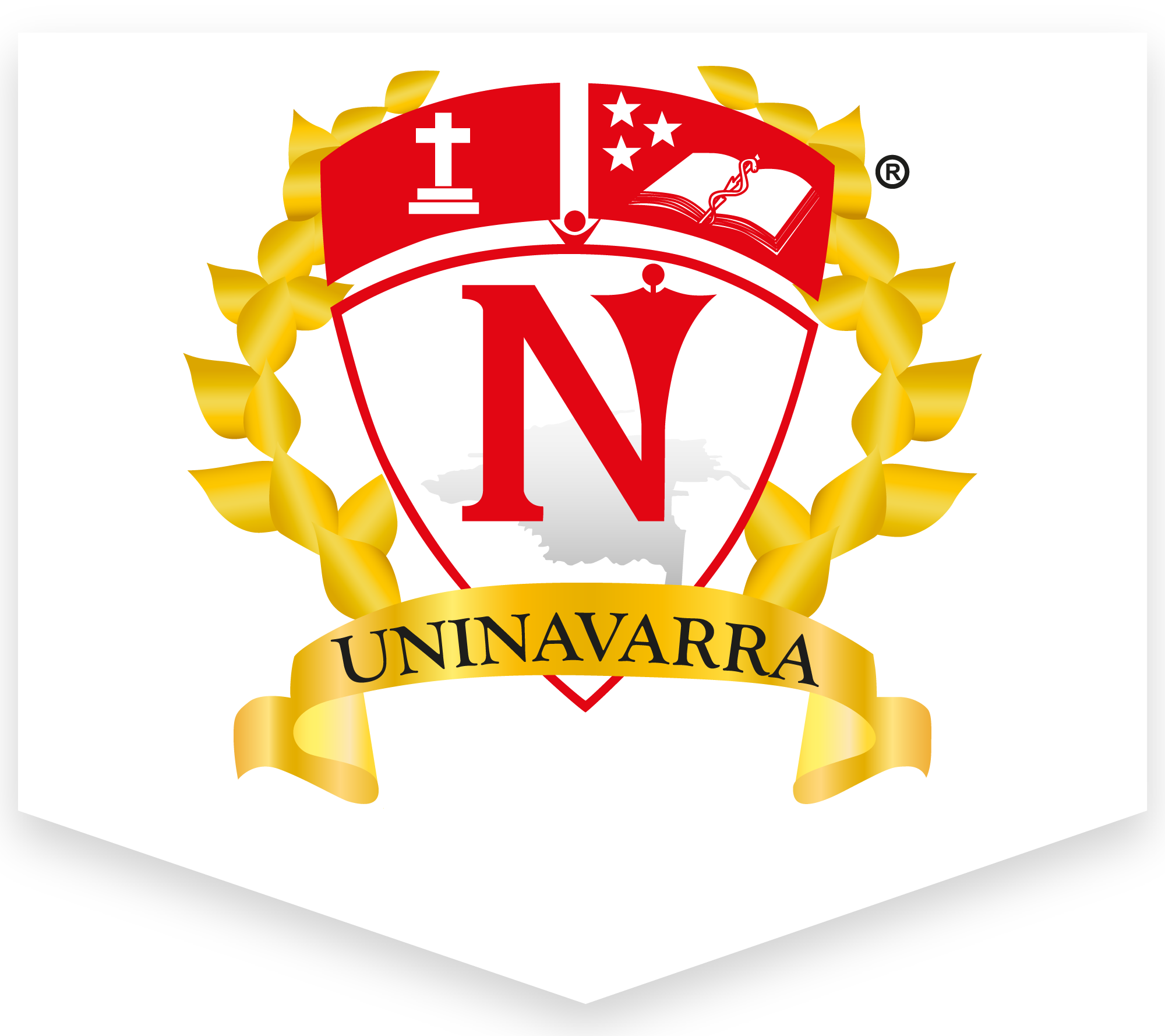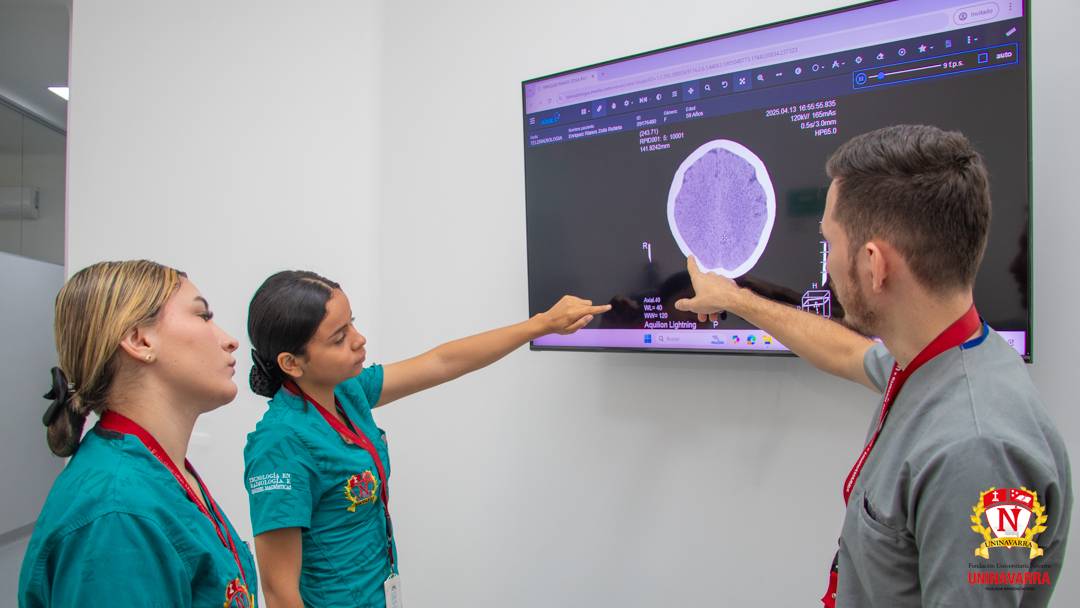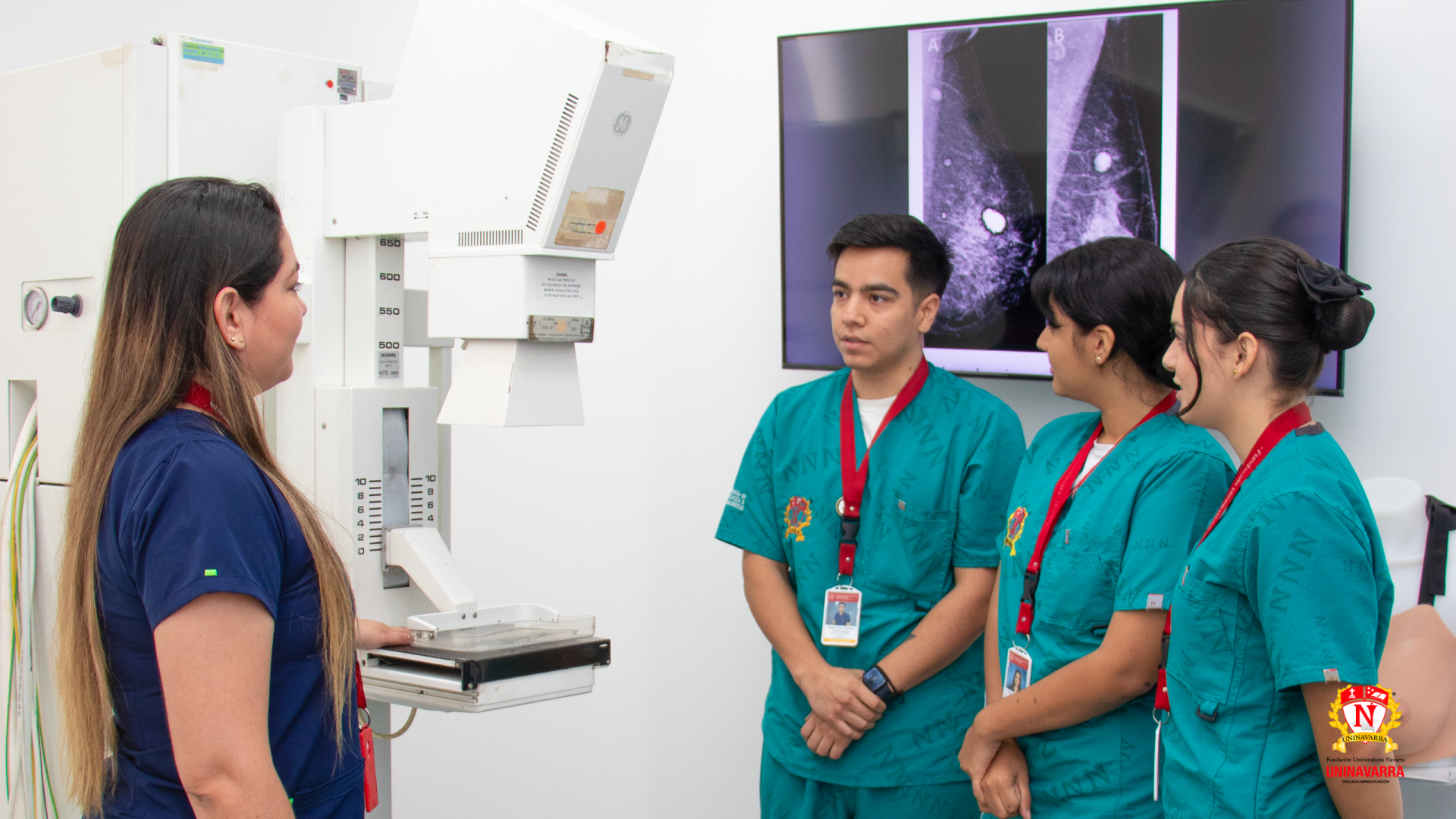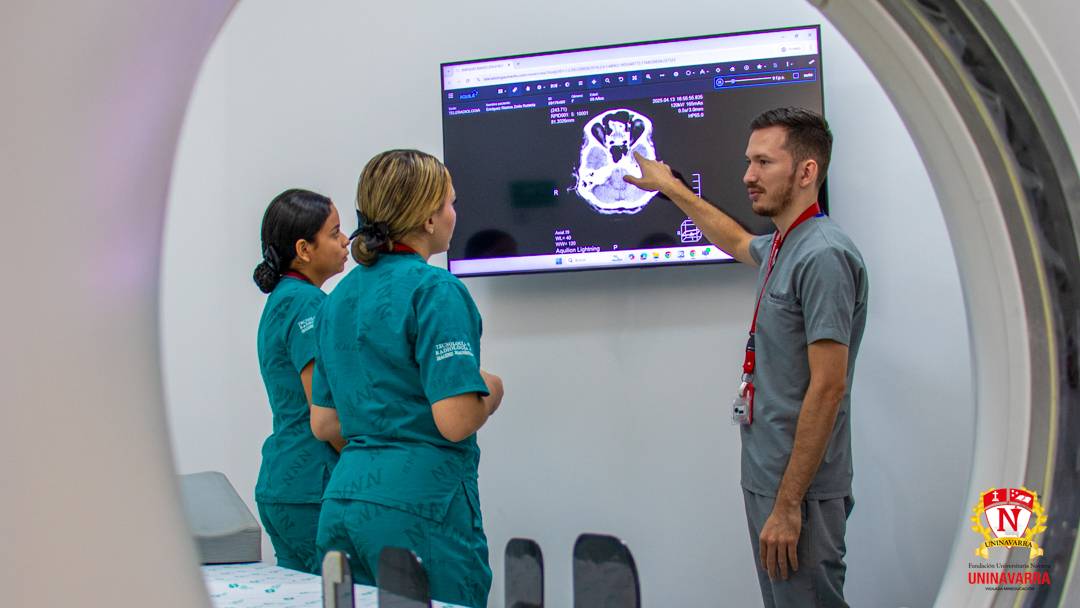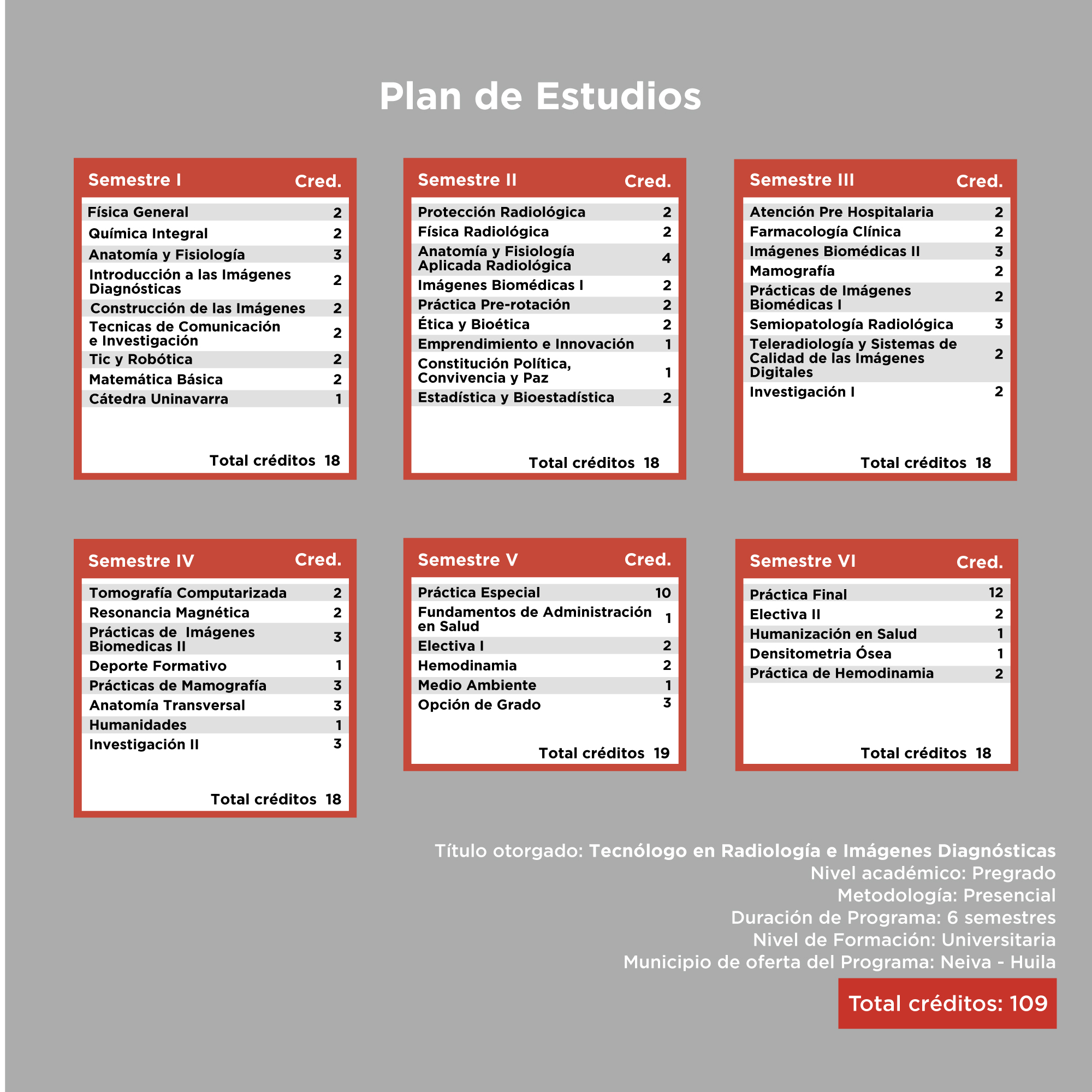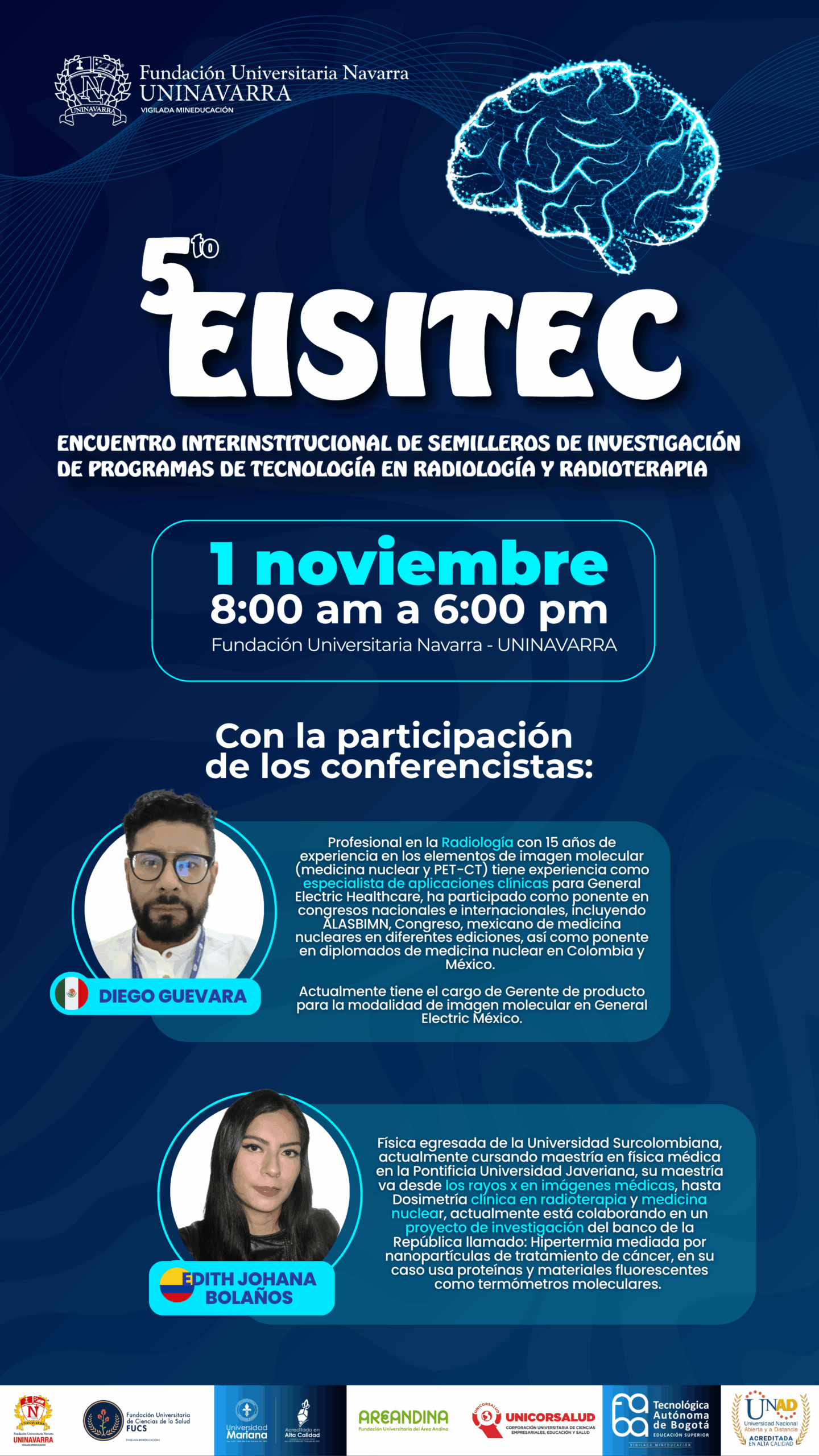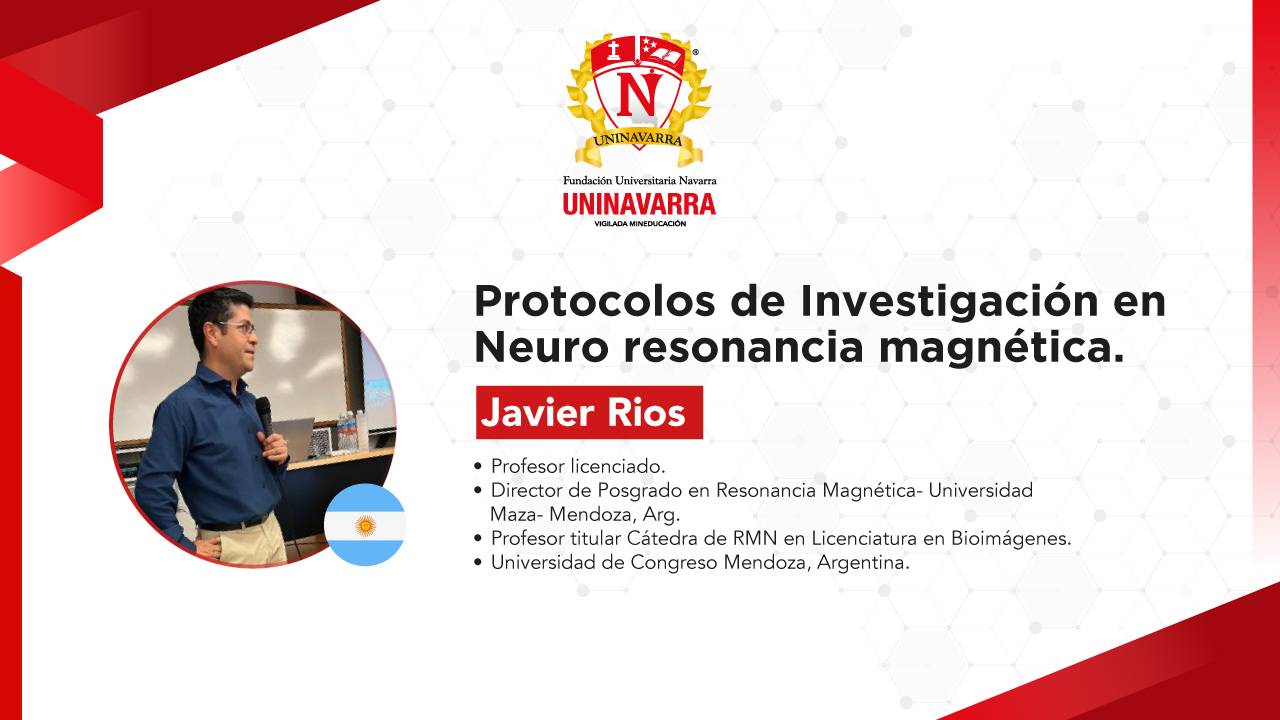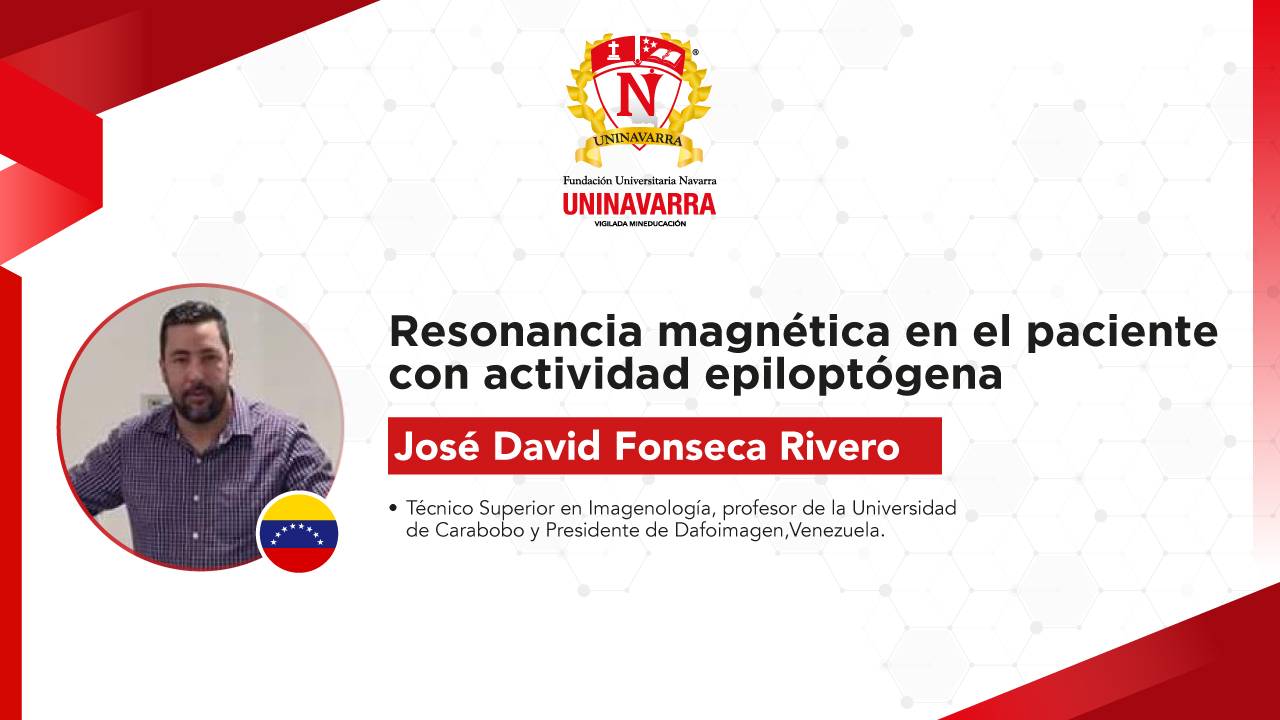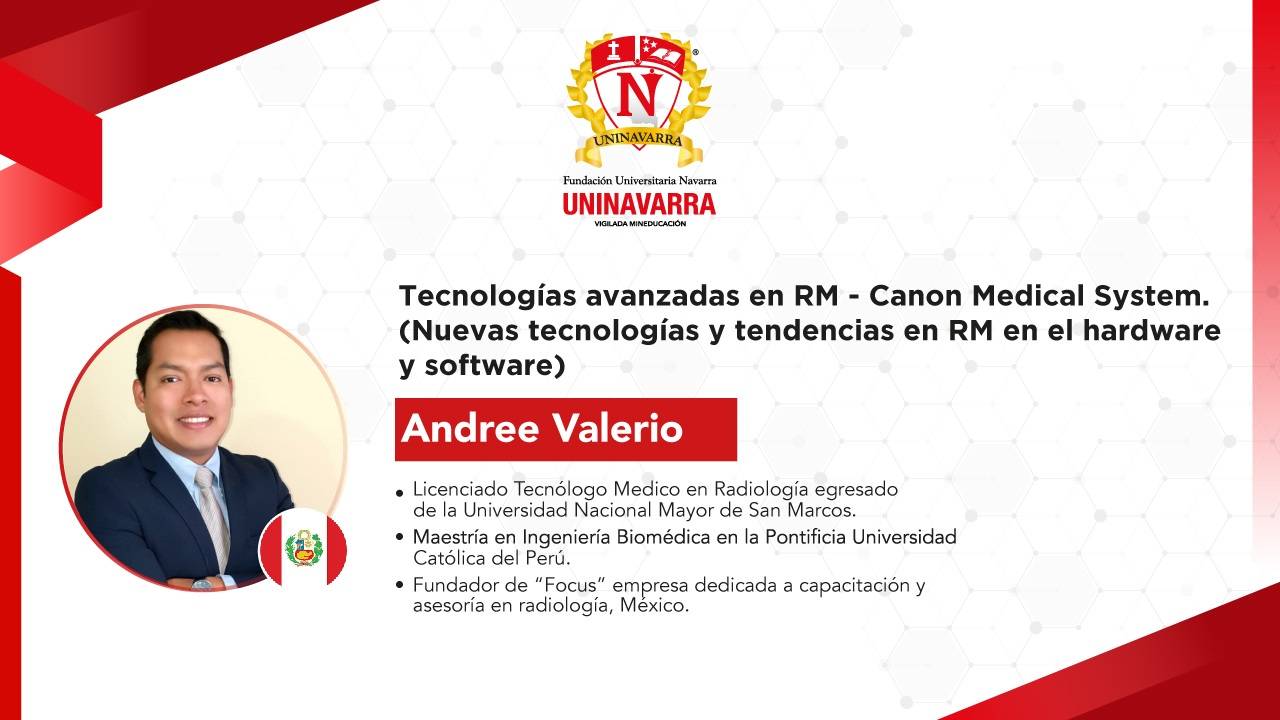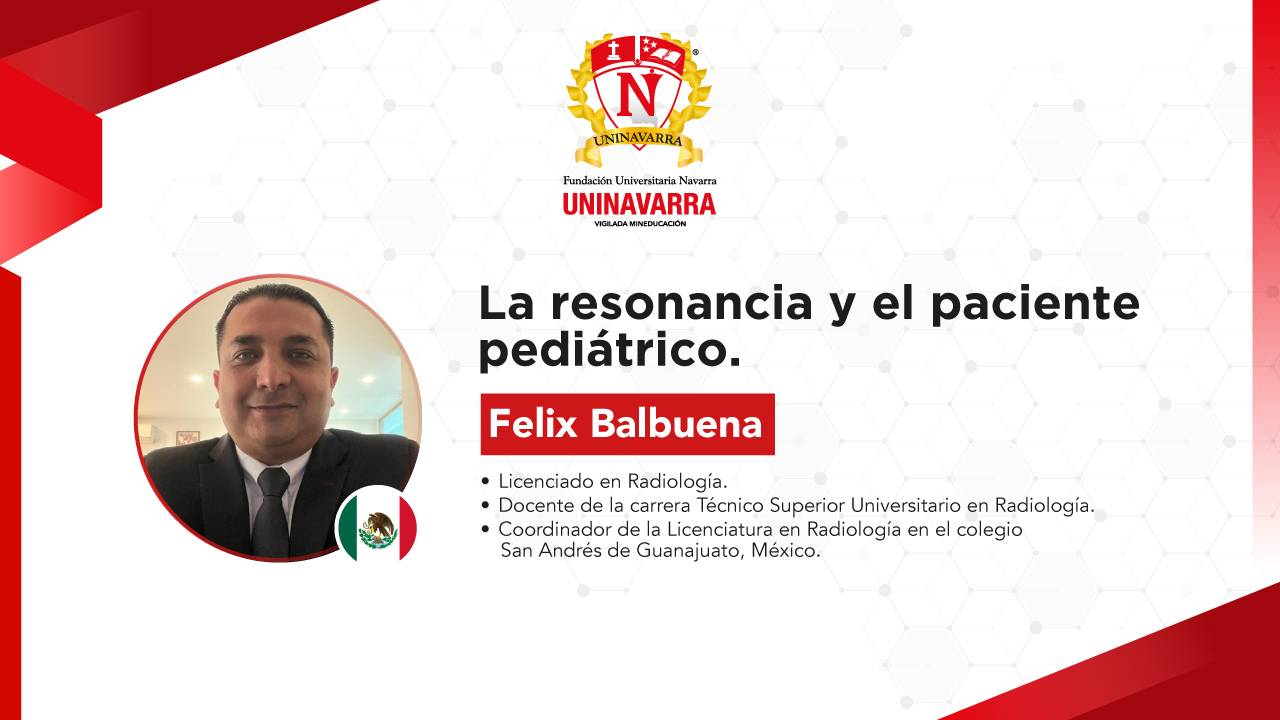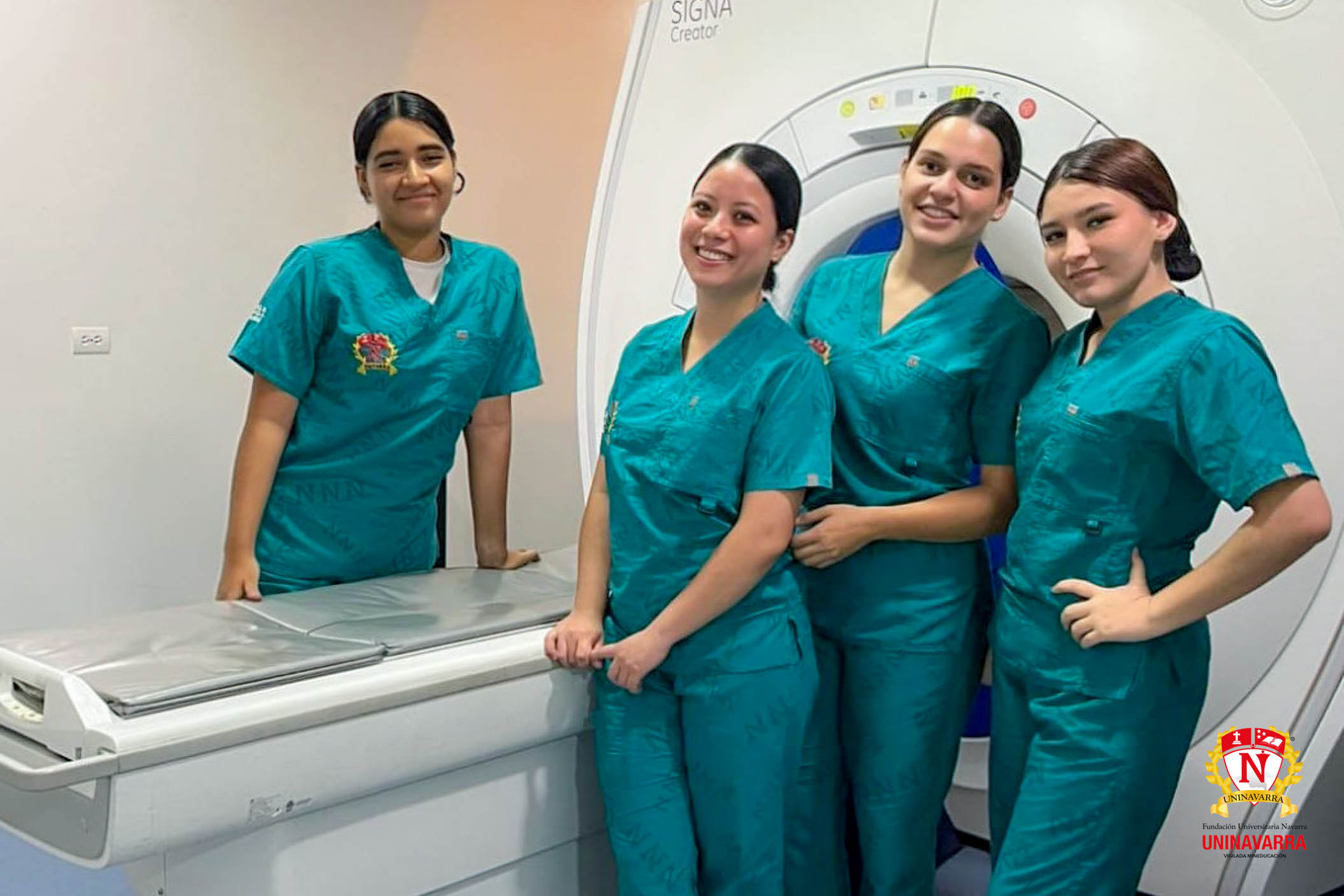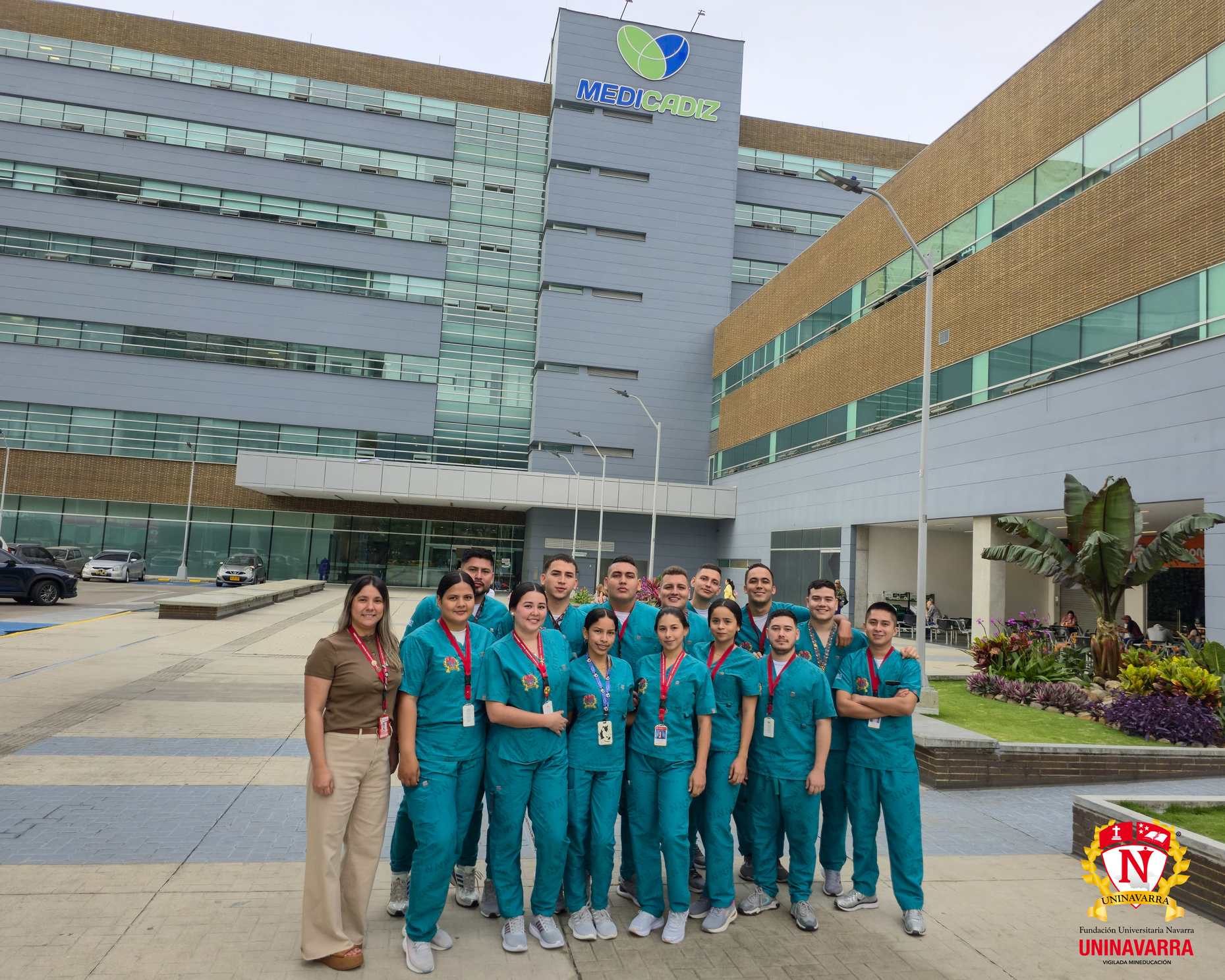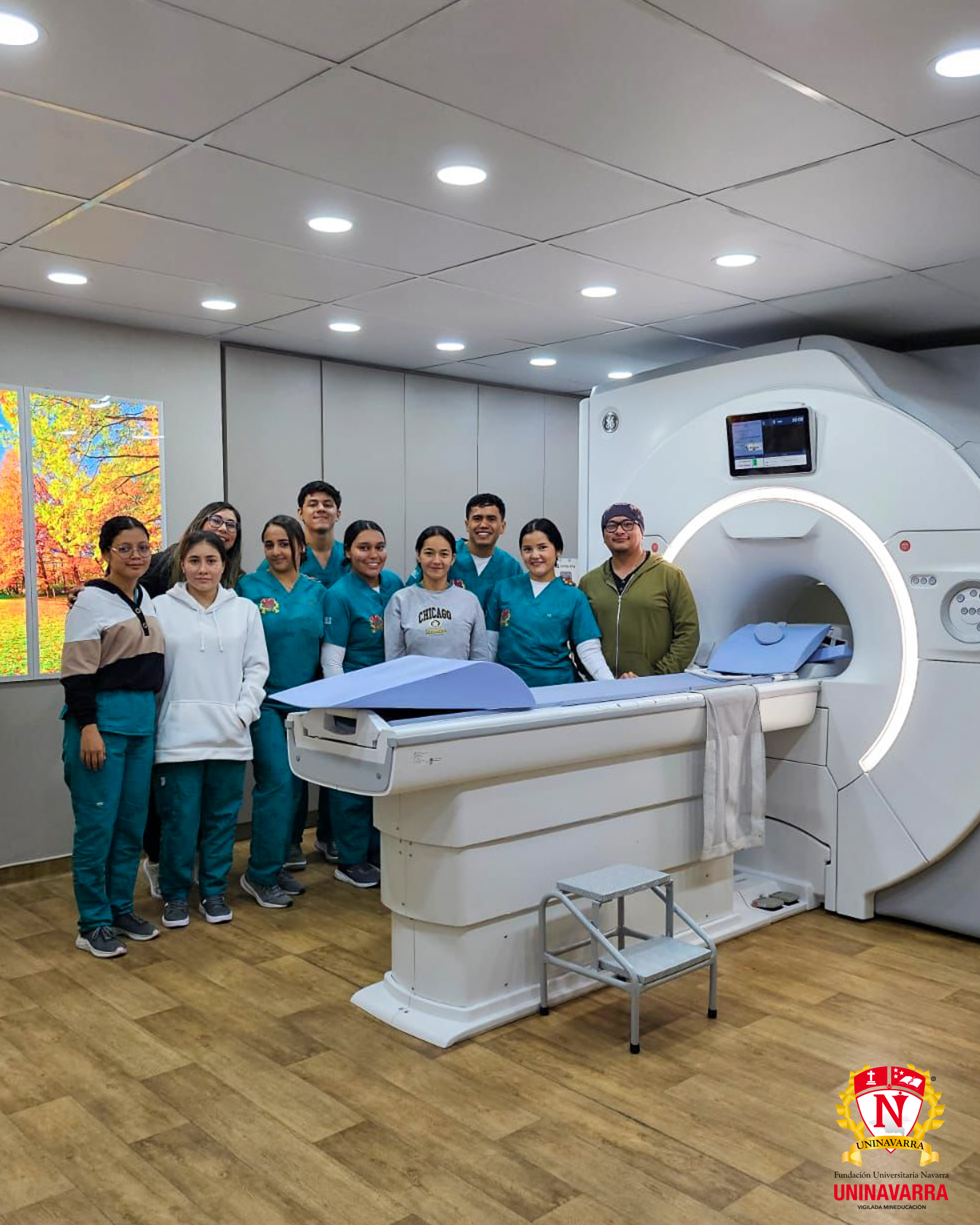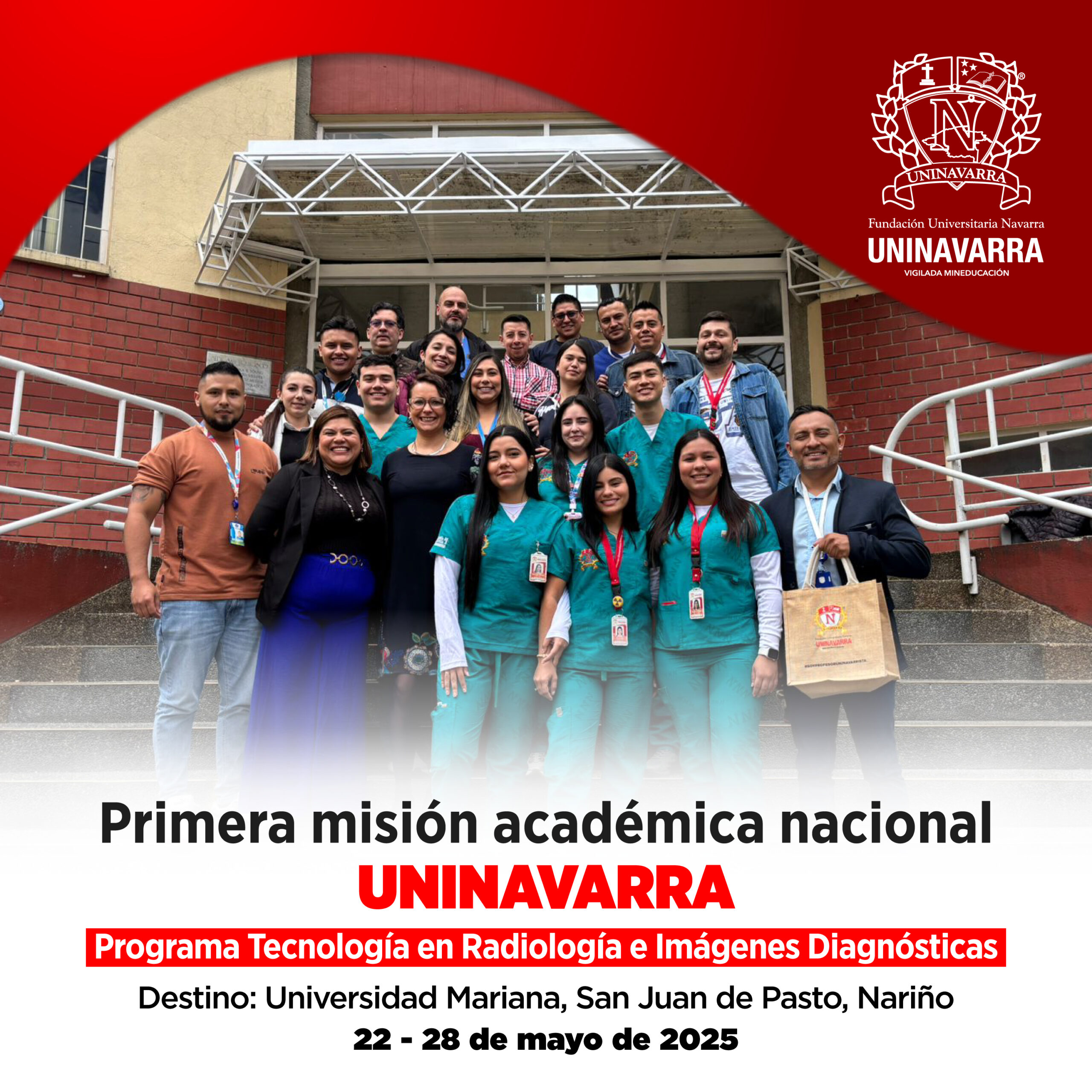| Title awarded: Radiology and Diagnostic Imaging Technologist |
| SNIES Code 103389 |
| Qualified Registration: Resolution 012515 of July 30, 2024 |
| Duration of the Program: 6 semesters |
| Number of academic credits: 109 |
| The program is attached: Faculty of Health Sciences and Basic Sciences |
| Academic Level: Undergraduate |
| Level of training: Technology |
| Methodology: On-site |
| Location: Neiva, Huila, Colombia |
| Periodicity of admission: Semiannual |
| Contacts: +57 318 071 5286 +57 317 514 1730 |
Presentation of the program
The Radiology and Diagnostic Imaging Technology program of the Navarra University Foundation - UNINAVARRA, through a modern, innovative, relevant and attractive training proposal, responds to a pressing need for training human talent to support the processes of comprehensive health care in the region and the country.
Currently, teaching-learning strategies in health have evolved substantially, placing clinical simulation as an essential part of the curricular and accreditation processes. That is why the Fundación Universitaria Navarra-UNINAVARRA, has the High Complexity Simulated University Hospital - HUSAC, considered as a high technology center equipped with integral scenarios that allow training, retraining and development of the skills required in medical practice, as well as in the competencies of future technologists in radiology and diagnostic imaging.
The program's curriculum is aimed at developing competencies and skills in the future technologist in radiology and diagnostic imaging, which are related to health promotion, disease prevention, diagnosis and treatment of the community; for which it is necessary to develop skills in each of the techniques of acquisition of diagnostic images currently available, as well as the analysis, processing, post processing and administration of diagnostic images acquired within the processes of safe care.
The mission of the Radiology and Diagnostic Imaging Technology program is in accordance with the institutional mission of the Navarra University Foundation-UNINAVARRA, with entrepreneurial vision, social responsibility and international projection; based on autonomous learning, with the ability to generate new knowledge and apply it within the diagnostic processes, under the principles of ethics, safety, responsibility and quality.
The future radiology technologist of the University Foundation Navarra-UNINAVARRA, has a comprehensive, holistic, critical thinking, reflective, creative and purposeful training of high human quality, with skills that allow him to make appropriate use of technologies for the realization of high quality diagnostic imaging according to the new market requirements and that will allow him to be at the service of society to care and care for their health.
The program of Technology in Radiology and Diagnostic Imaging of the University Foundation Navarra-UNINAVARRA, aims to be by the year 2027 a program of high academic quality, recognized nationally and internationally as a program with academic excellence, distinguished by implementing within the training process components of international interaction, research, social projection, extension and entrepreneurship; forming technologists in radiology capable of impacting and transforming society through implementation of biomedical equipment for the acquisition of diagnostic images with ethics and responsibility.
Entry requirements
Documents for registration
- Photocopy of identity card
- Certificate of being affiliated to the social security health system.
- Certificate of results of current State Examinations or Tests (ICFES or SABER 11).
- Photocopy of the Diploma or Certificate of Graduation or Certification of being in the last grade of High School - Grade Eleven - (The certification applies to those students who aspire to obtain their high school diploma before the beginning of class).
- If the applicant is a graduate, photocopy of diploma or degree certificate
- If the applicant is a foreigner, he/she must comply with the legal norms of the country in terms of permanence and study, as well as present a certificate evidencing the passing of a Spanish language proficiency exam.
Evidence to be submitted:
- Interview by psychology
- Interview by program director
- Psychometric personality test
Applicant Profile
The general entry profile and admission requirements:
Admission to the Navarre University Foundation-UNINAVARRA is free and voluntary, by enrollment processes of applicants according to their vocation. Admission to UNINAVARRA is based on three profiles:
- Personal profile, where the applicant's personality traits are evaluated to verify affinity with the program's entrance profile.
- Intellectual profile, which evaluates the degree of knowledge and, based on the State Tests of Aptitude and Knowledge of the Colombian Institute for the Promotion of Higher Education (ICFES).
- Attitudinal profile, determined in interview processes in which the program director will determine the affinity between the student and the formative requirements of the program. In the case of Health Sciences and Clinical Sciences, psychometric personality tests will be specifically applied to evaluate the psychological profile from a clinical perspective, in order to ensure the applicant's affinity and stability with the career.
The applicant who enters the program of Technology in Radiology and Diagnostic Imaging, must be a person, who having fully complied with the requirements of secondary education, is interested in comprehensive training with values and humanistic principles, sensitive to the human being, learning skills, motivation and commitment, which allows him/her to be part of multidisciplinary teams of health care in the professional field and contribute to the progress of the country with justice and equity.
Professional profile
The profile of the technologist in radiology and diagnostic imaging of UNINAVARRA, is that of a professional in the area of health with training: comprehensive, humanistic, ethical and investigative; possessing biomedical skills and the necessary responsibility for the acquisition, processing, post processing and sending of diagnostic images; making responsible use of safety protocols and radiation protection. Permanently in search of innovation and continuous professional training, strengthening updated concepts in the operation of high technology diagnostic acquisition equipment and use of hospital networks in order to obtain high quality images. Likewise, it is able to create, undertake and manage diagnostic imaging centers, with criteria of sustainability, sustainability and social responsibility, locally, nationally and internationally.
Occupational profile
The technologist in radiology and diagnostic imaging of the University Foundation Navarra - UNINAVARRA, will apply the learning outcomes acquired in their training, performing at the level of care, managerial-administrative and research applying the skills acquired in different fields of action at local, national and international level.
Therefore, the technologist in radiology and diagnostic imaging of the University Foundation Navarra- UNINAVARRA will be able to perform in both general and specialized areas, in the following occupational scenarios:
- Care area
- Administrative area
- Research area
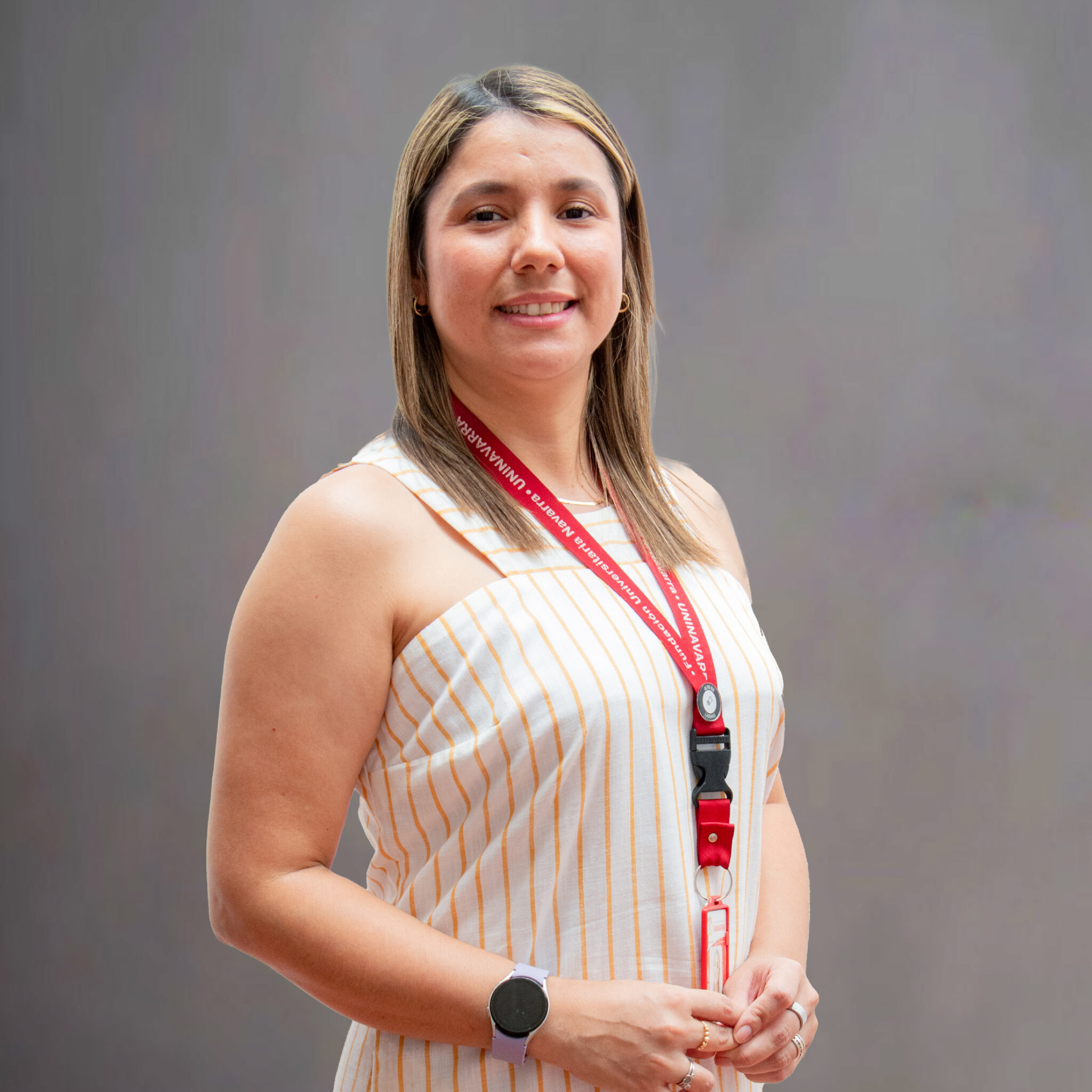
Anny Briyith Aquite Agudelo
Program Director
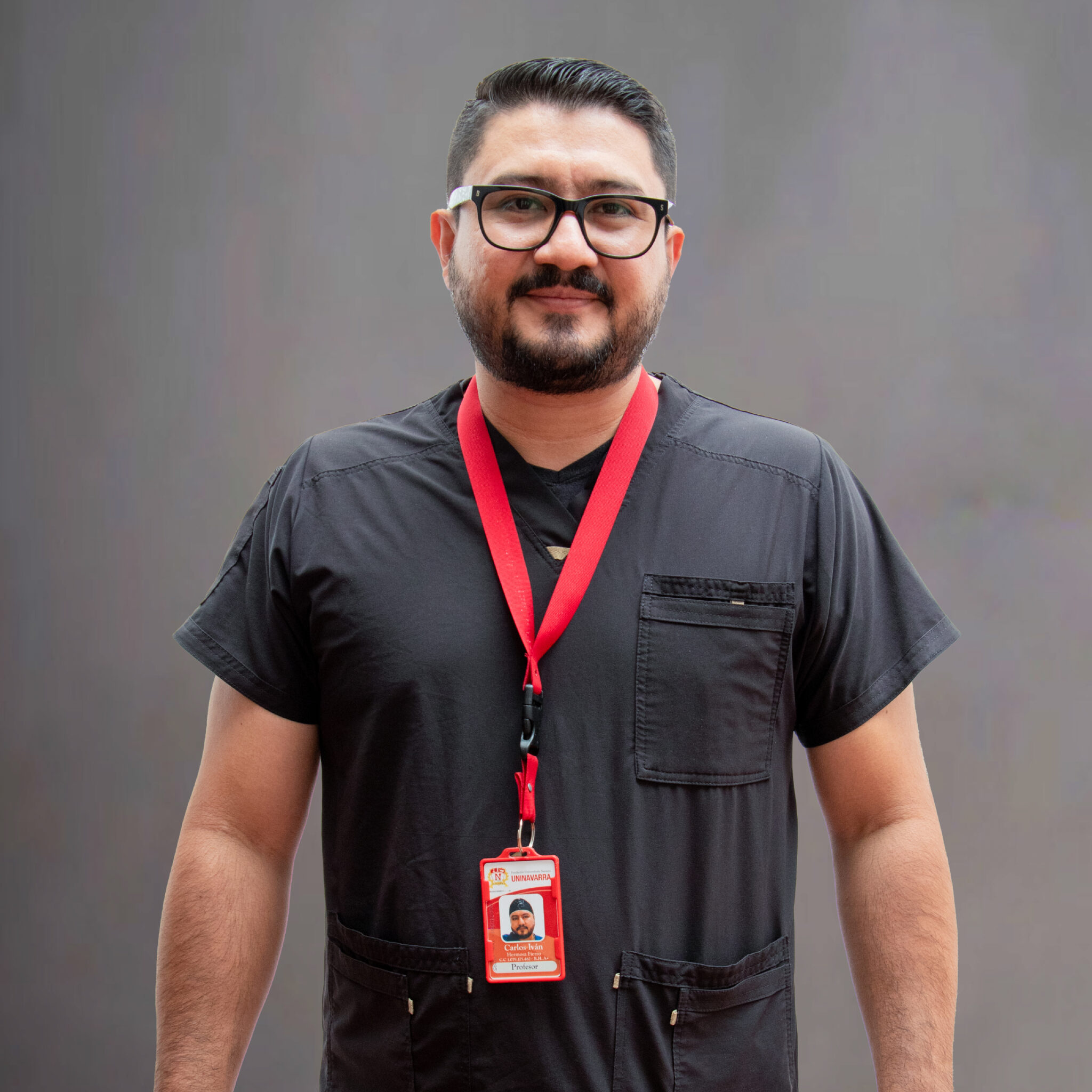
Carlo Iván Hermosa Fierro
Program manager
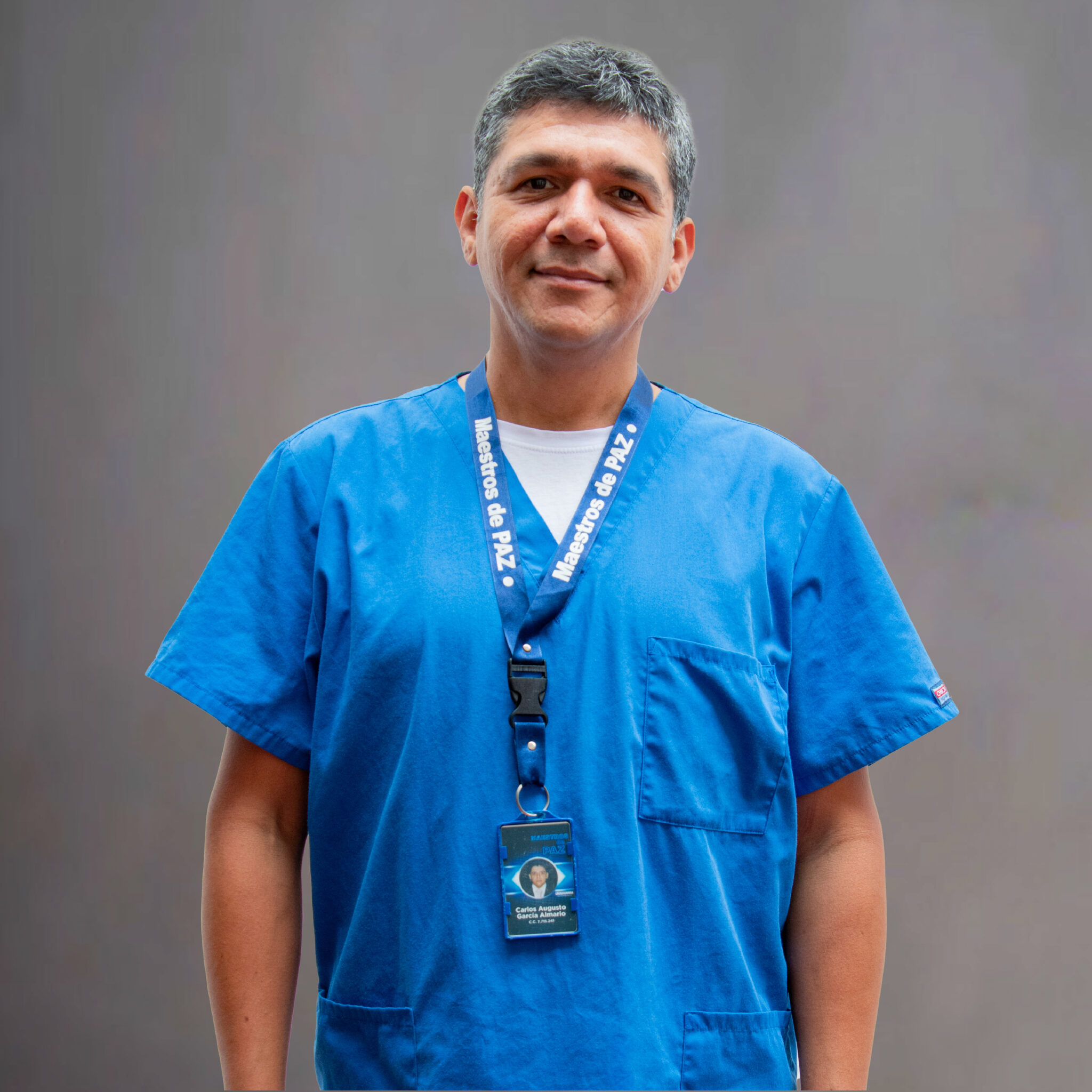
Carlos Augusto García Almario
Internship Coordinator
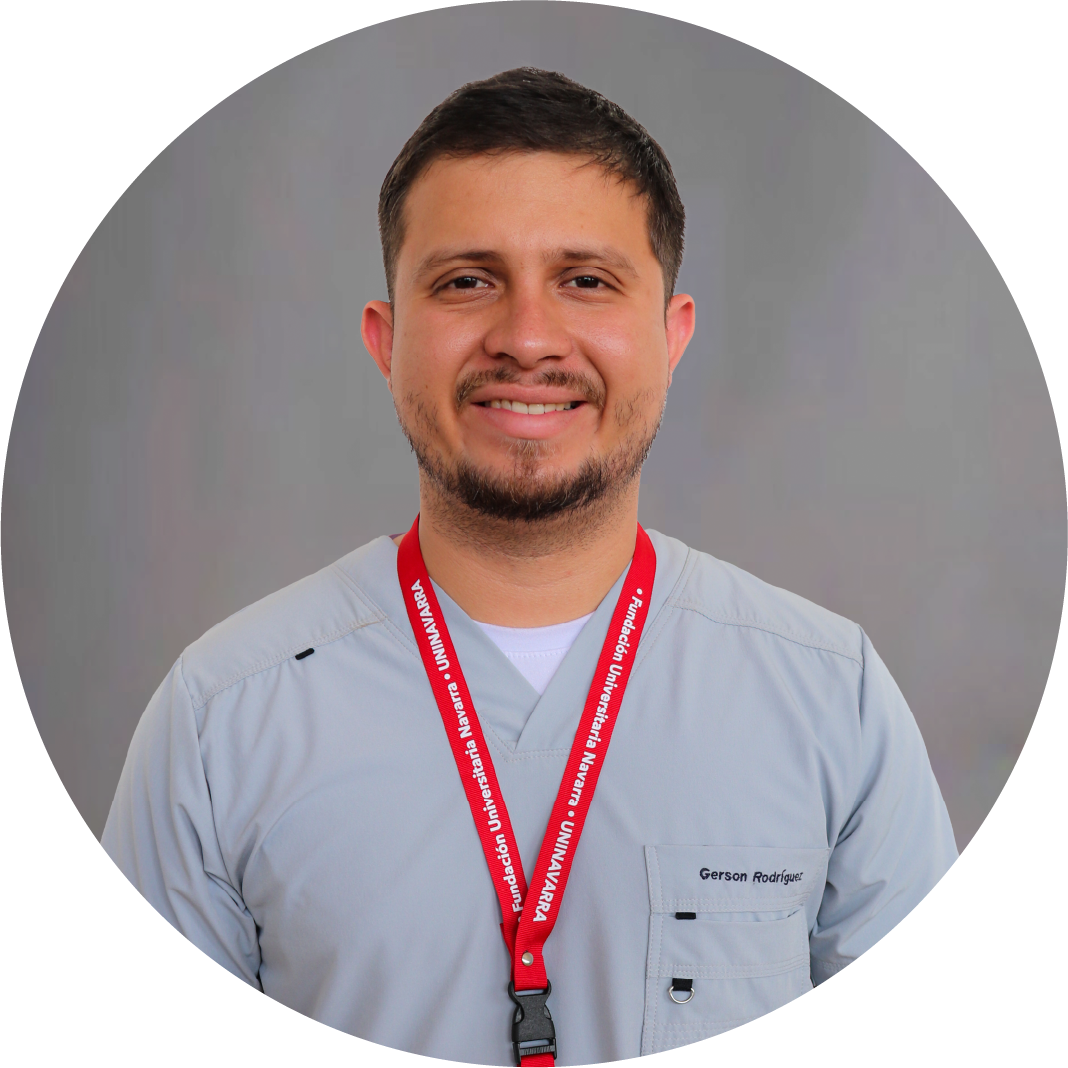
Gerson Alexander Rodriguez Ospina
Professor
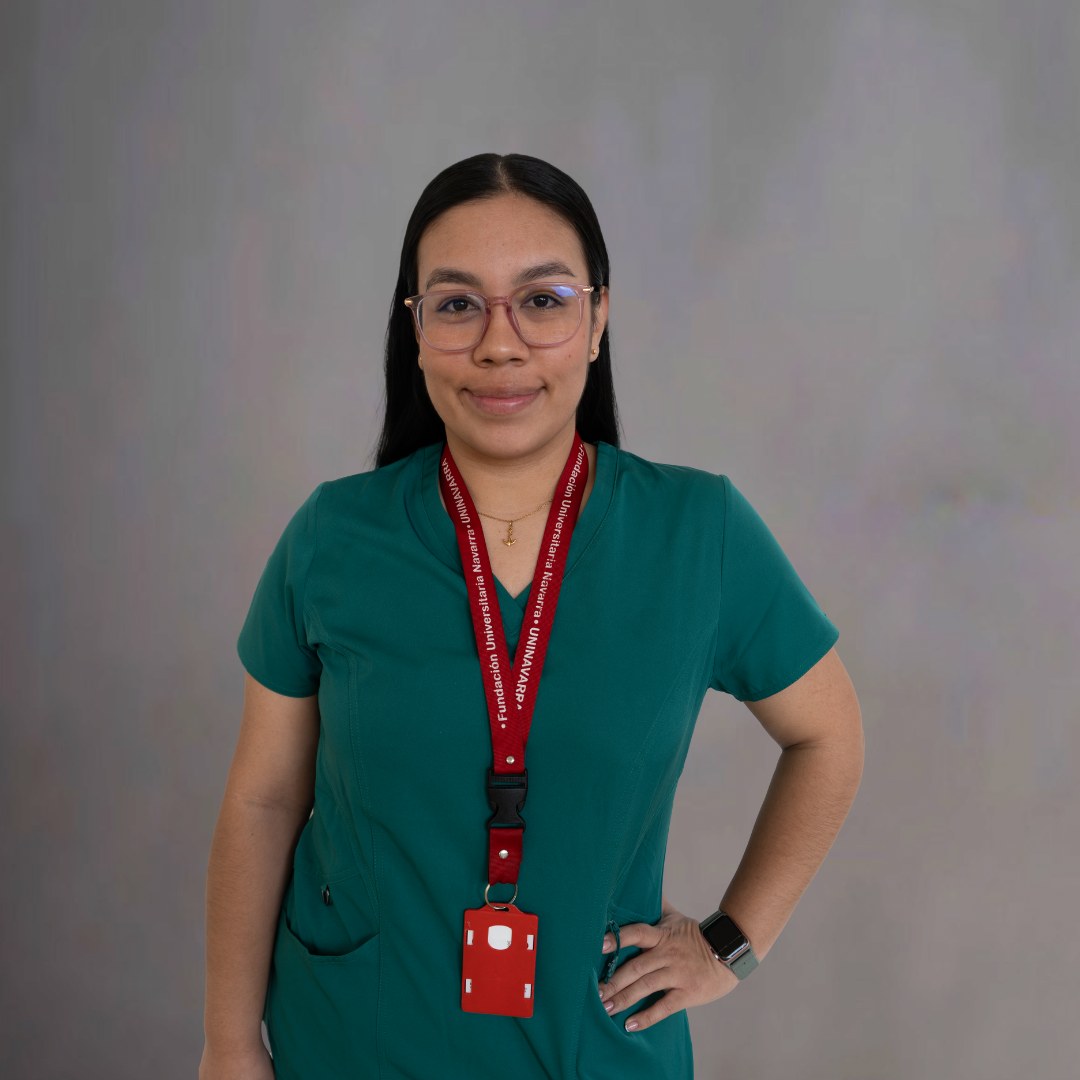
Laura Tatiana Artunduaga
Professor

Jhon Estiven Arias Gil
Professor
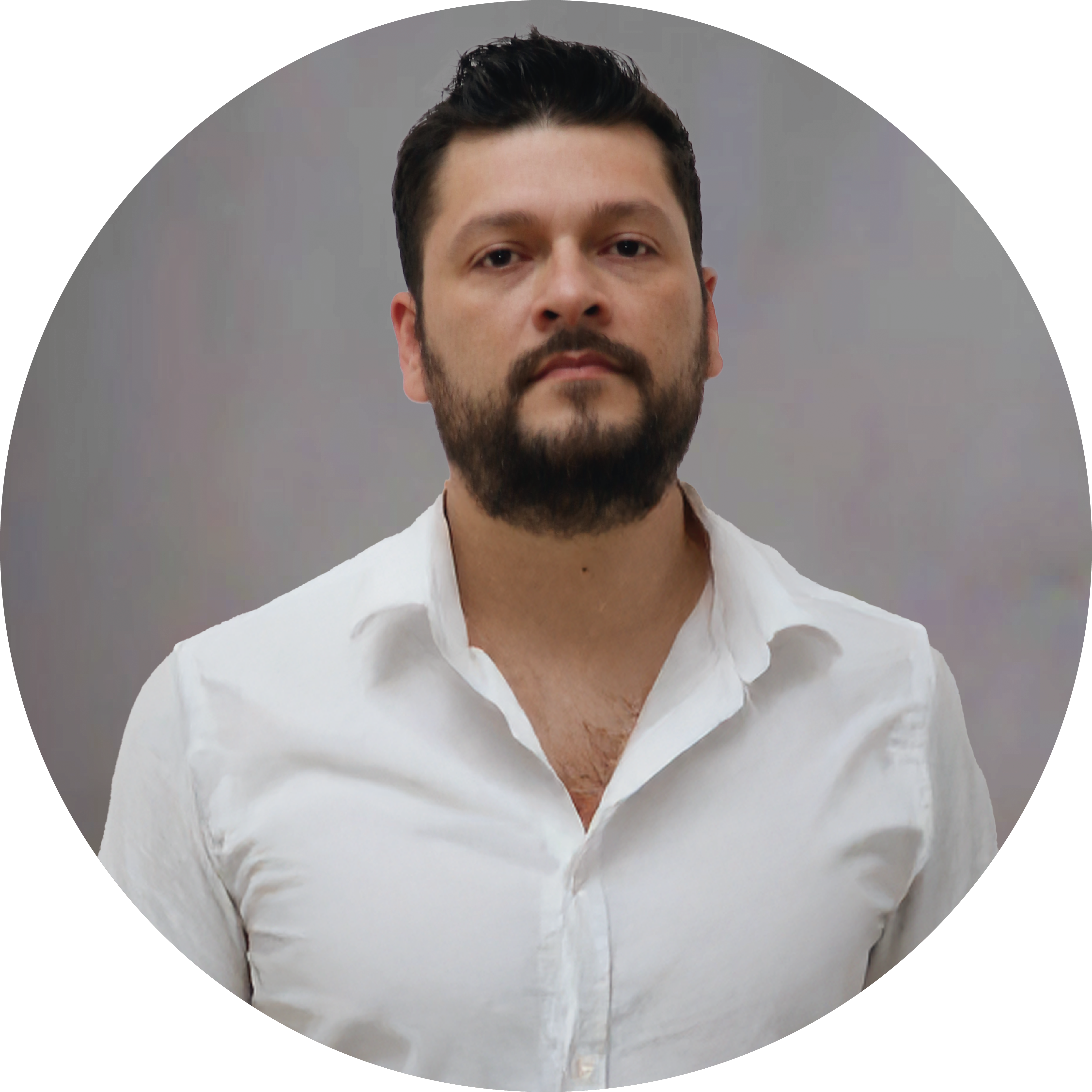
Gustavo Adolfo Albornoz Bonilla
Professor
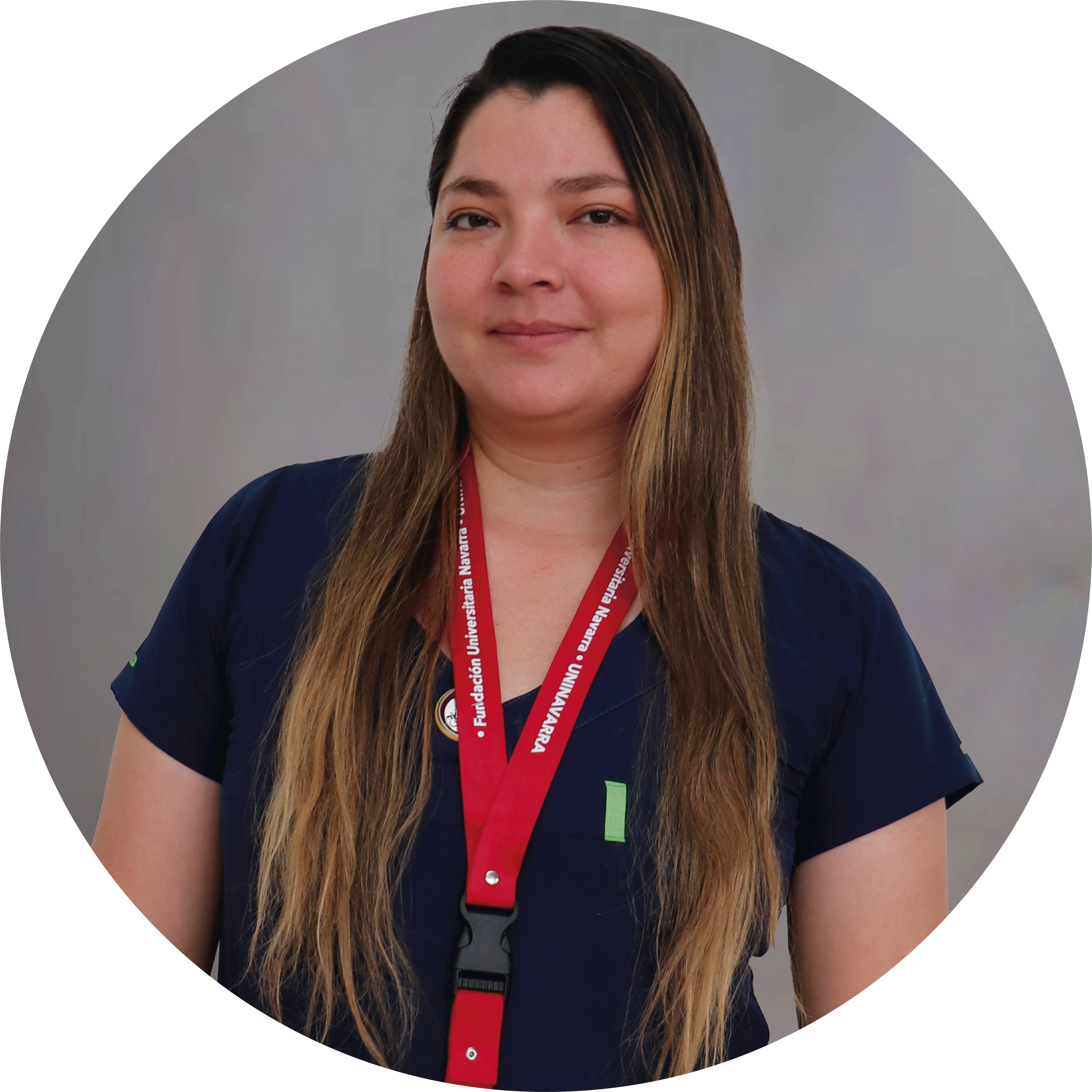
Aura Cristina Perez Gonzales
Professor
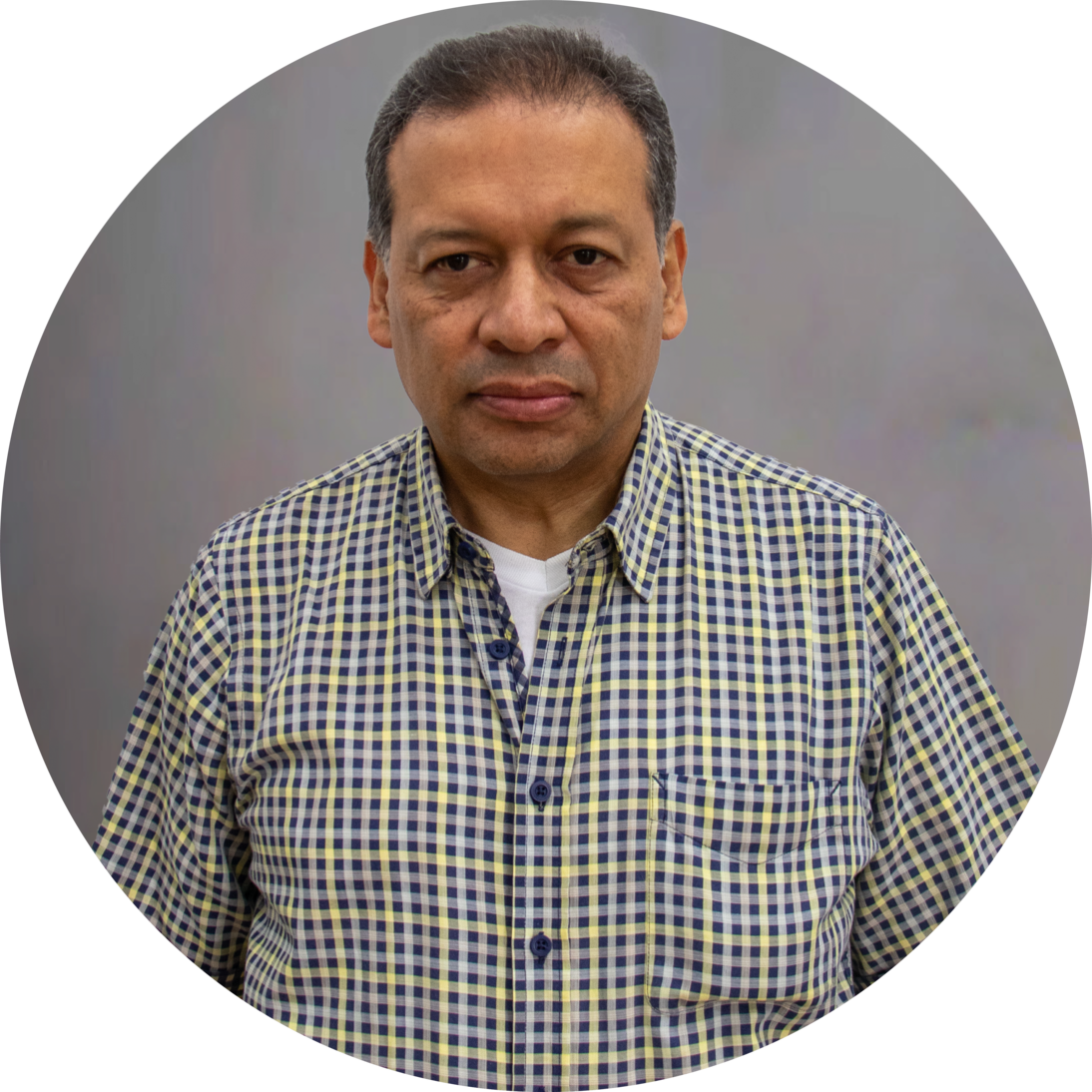
Rodrigo Acevedo Varon
Professor
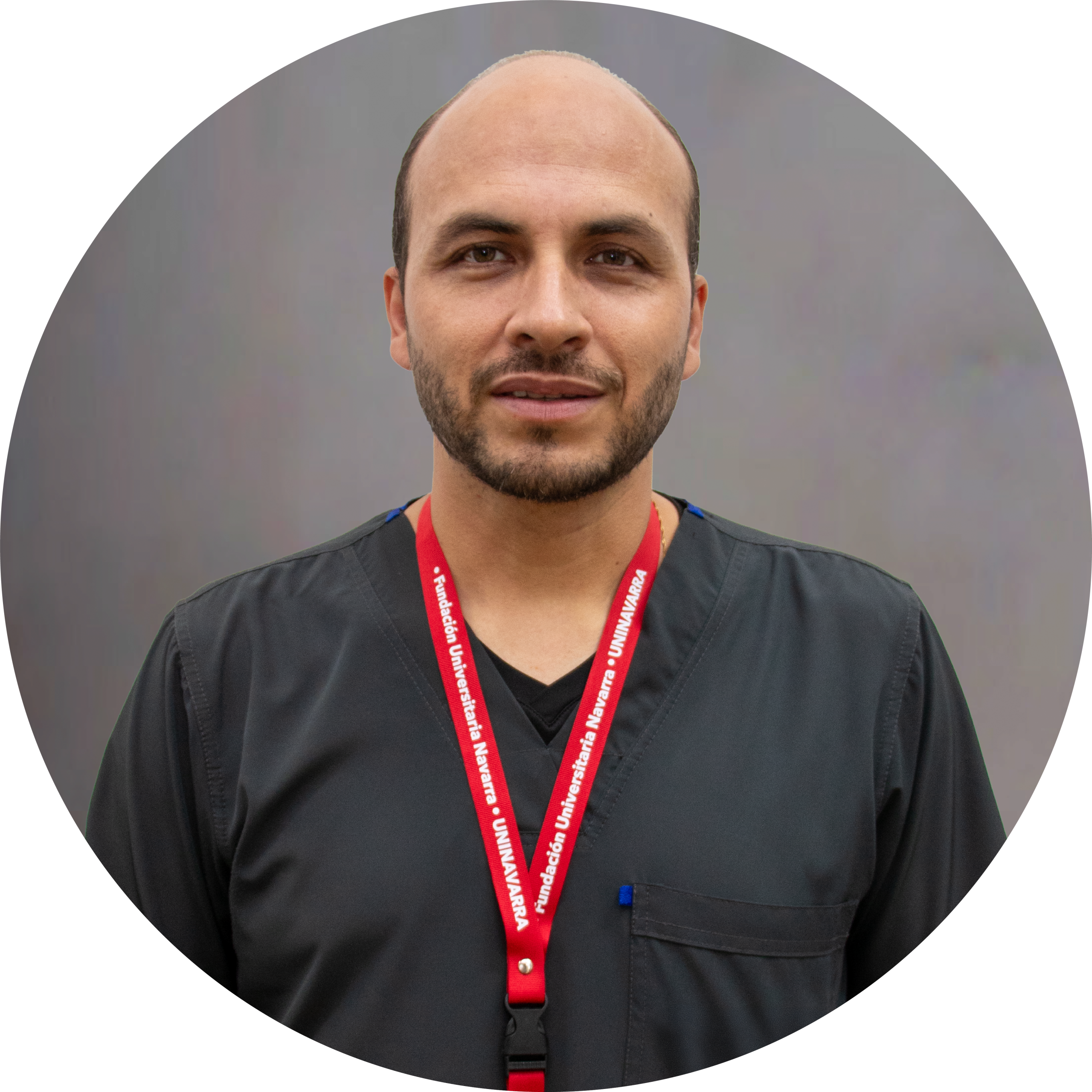
Ricardo Rivera Zúñiga
Professor
IV Congreso Nacional e Internacional de Innovación e Investigación en Radiología e Imágenes Diagnósticas
El IV Congreso Nacional e Internacional de Innovación e Investigación en Radiología e Imágenes Diagnósticas, realizado de manera presencial en la ciudad de Neiva del 5 al 7 de noviembre de 2025, tuvo como eje central el Metaverso. Este encuentro académico reunió a profesionales, investigadores y estudiantes de diversas regiones del país y del mundo, consolidándose como un espacio de vanguardia donde se exploraron nuevas tecnologías inmersivas aplicadas a los escenarios clínicos y educativos de la radiología.
Este importante evento fortaleció la apropiación social del conocimiento y la divulgación científica, al integrar conferencias magistrales, ponencias de expertos internacionales, nacionales y regionales y la presentación de trabajos libres que evidenciaron avances significativos en investigación, simulación médica e innovación tecnológica. La edición 2025 reafirmó el compromiso de UNINAVARRA con el desarrollo científico y la formación de profesionales capaces de liderar la transformación digital del sector salud desde la era del metaverso.
V Encuentro interinstitucional de Semilleros de Investigación de los Programas de Tecnología en Radiología y Radioterapia EISITEC.
El “V Encuentro Interinstitucional de Semilleros de Investigación de Programas de Tecnología en Radiología y Radioterapia EISITEC” tiene como objetivo promover un espacio académico y colaborativo que reúne a estudiantes, docentes e investigadores de diversas instituciones con el propósito de compartir experiencias, avances y proyectos que fortalezcan la investigación en nuestro campo, promoviendo el aprendizaje colectivo, la creación de redes académicas y el fortalecimiento de nuestras competencias profesionales.
Este evento representó una valiosa oportunidad para exponer ideas, debatir propuestas y fomentar el intercambio de conocimientos, impulsando así la innovación y el desarrollo científico.
La participación de las diferentes instituciones de educación superior, son clave para continuar construyendo un futuro con más investigación, mejores prácticas y un mayor impacto social en el ámbito de la salud.
IV International Conference on Diagnostic Imaging Update "Technological Trends and Advanced Applications in Conventional Radiology".
In the current context of digital transformation and accelerated advances in medical technology, constant updating in the area of diagnostic imaging is essential for radiology students and professionals. The "IV International Conference on Updating in Diagnostic Imaging", held in virtual format, responded to this need through a rigorous academic platform oriented to continuous training, critical analysis and interdisciplinary debate.
During the event, key topics such as the integration of new technologies, the use of artificial intelligence in radiology, the optimization of diagnostic protocols and compliance with international quality and safety standards were addressed. These topics helped to strengthen the technical and analytical skills of the attendees, promoting evidence-based clinical practice aligned with global trends in medical innovation.
The event had the outstanding participation of speakers from Chile, Colombia and Mexico, which enriched the academic exchange and fostered an international vision of the challenges and opportunities in the radiological field. Thanks to its virtual format, the event facilitated broad and diverse access to knowledge, consolidating itself as a reference space for collaborative learning in the region.
III International Conference on Diagnostic Imaging Update. "The Revolution of Magnetic Resonance Imaging".
Magnetic Resonance Imaging is a crucial diagnostic technique used worldwide, standards and practices may vary between different countries and regions, but it also allows healthcare professionals to share knowledge and experience, which encourages standardization and continuous improvement of the quality of MRI care worldwide.
International collaboration in MRI training and refresher training can help address common challenges and problems faced by professionals in different parts of the world. This includes issues related to patient safety, image interpretation, and implementation of new technologies and techniques.
This Update Day also offers the opportunity to learn from world-renowned experts and to access resources and advances that may not be readily available in a single country, which enriches the education and professional development of participants, ultimately resulting in improved quality of care provided to patients, regardless of their geographic location.
II International Conference on Diagnostic Imaging Update - Computed Tomography. "Evolution in diagnosis".
Computed tomography (CT) was, at the time of its clinical introduction in 1971, an X-ray modality that allowed only axial images of the brain of interest in neuroradiology to be obtained. With the passage of time it has become a versatile imaging technique, with which three-dimensional images of any anatomical area can be obtained, and which has a wide range of applications in oncology, vascular radiology, cardiology, traumatology, or interventional radiology, among others.
On the other hand, existing technologies evolve in such a way that nothing will ever be the same again. Innovation drives a technology forward and forces us to rethink what we saw as established; that is why the Navarra-UNINAVARRA University Foundation, in its commitment to high quality education, considered it pertinent to carry out the second Update Day; this time focused on Computed Tomography (CT), addressing issues of acquisition, processing, post processing and artificial intelligence in the service of medical diagnosis.
We are confident that the health systems are called upon to advance the implementation of new and better medical management tools that generate value and social impact. In this path, cutting-edge technology plays an increasingly important role when it comes to taking processes that include thorough analysis and image-guided therapies to another level, taking a big step toward improving patient care in various clinical areas by effectively showing things that are impossible to see with conventional CT scans.
UNINAVARRA facing the world
We have an Internationalization Policy "UNINAVARRA FACING THE WORLD"which aims to offer the academic community a bridge between the local environment and the globalized world. Through its lines of action, it provides opportunities for interaction with the national and international environment in classroom and online mode, where you can live training experiences in other contexts, interact with people from different cultures, learn about the global dynamics and its social, cultural, economic, environmental changes, among others; enhance your career with national and international projection and strengthen your training as a global professional and citizen of the world.
Lines of action and opportunities:
- International Cooperation Management: Agreements, alliances, joint projects and networking with more than 200 institutions from different countries around the world such as Argentina, Brazil, Canada, Chile, Spain, United States, Italy, Mexico, Peru, among others.
- Academic Mobility Management: Student exchange opportunities during one or two academic periods throughout the development of the student's academic program in different types of mobility such as: academic exchange (taking subjects), short course, internship, practicum, medical rotation, mission, research stay, observership and degree modalities. Teaching mobility as national and foreign visiting professors in your classroom.
- Multiculturalism and Multilingualism Management: Activities that contribute to the development of intercultural competencies and communicative competence in a foreign language, mainly English as a universal language.
- Management of the Internationalization of the Curriculum: Joint classes with other institutions through mirror class methodology or COIL (Collaborative Online International Learning).
More information: https://uninavarra.edu.co/internacionalizacion/
Events
Why study Radiology and Imaging Technology?
Diagnostics at UNINAVARRA?
Internship agreements
- Hernando Moncaleano Perdomo University Hospital
- E. E. S. E. Carmen Emilia Ospina
- Emcosalud Clinical Society.
Related Programs
